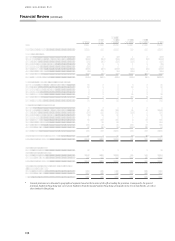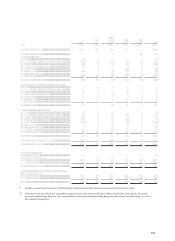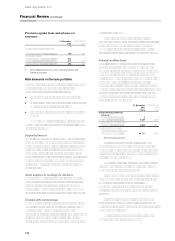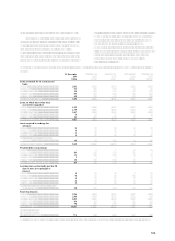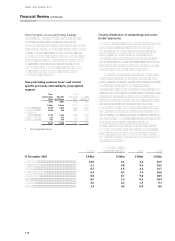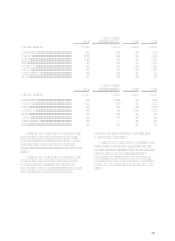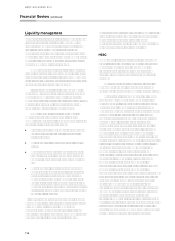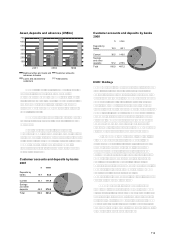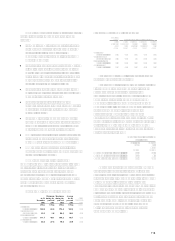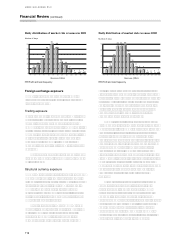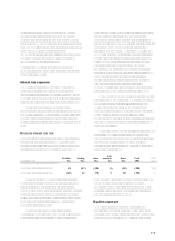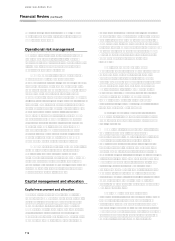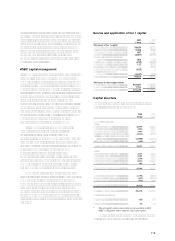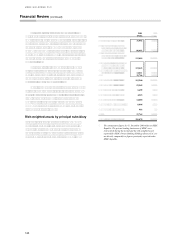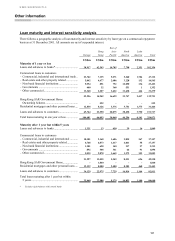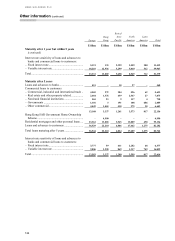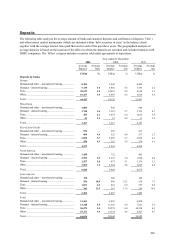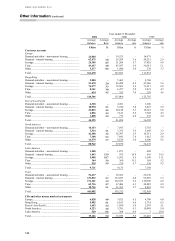HSBC 2001 Annual Report Download - page 116
Download and view the complete annual report
Please find page 116 of the 2001 HSBC annual report below. You can navigate through the pages in the report by either clicking on the pages listed below, or by using the keyword search tool below to find specific information within the annual report.
HSBC HOLDINGS PLC
Financial Review (continued)
114
Market risk management
Market risk is the risk that foreign exchange rates,
interest rates or equity and commodity prices will
move and result in profits or losses to HSBC. Market
risk arises on financial instruments which are valued
at current market prices (mark-to-market basis) and
those valued at cost plus any accrued interest
(accruals basis).
Trading positions are valued on a marked to
market basis.
In liquid portfolios, the market values are
determined by reference to independently
sourced mid-market prices where it is reasonable
to assume the positions could be sold at that
price. In those instances where markets are less
liquid and/or where positions have been held for
extended periods, portfolios will be valued by
reference to bid or offer prices as appropriate.
In relation to certain products, such as over-
the counter derivative instruments, there are no
independent prices quoted in the markets. In
these circumstances market values are
determined by reference to standard industry
models, which typically utilise discounted cash
flow techniques to derive the market value. The
models may be in-house developed or software
vendor packages.
In valuing transactions, prices may be
amended in respect of those positions considered
illiquid, having recognition of the size of the
position vis-a-vis the normal market trading
volume in that product.
The main valuation sources are securities
prices, foreign exchange rates, and interest rate
yield curves.
In excess of 95 per cent of HSBCs
derivative transactions are in plain vanilla
instruments, primarily comprising interest rate
and foreign exchange contracts, where the
marked to market values are readily determinable
by reference to independent prices and valuation
quotes, as described above.
In the limited number of circumstances, where
standard industry models are not available, and
where there is no directly relevant market quotation,
HSBC has developed its own proprietary models for
the purposes of performing valuations. Such
circumstances normally would be where HSBC has
tailored a transaction to meet a specific customer
need. The models used are checked by Finance and
Operations departments and are subject to audit
review on an ongoing basis to ensure that the model
assumptions are, and remain, valid over the
transaction life which is generally less than five
years.
HSBC makes markets in exchange rate and
interest rate instruments, as well as in debt, equities
and other securities. Trading risks arise either from
customer-related business or from position taking.
HSBC manages market risk through risk limits
approved by the Group Executive Committee.
Traded Markets Development and Risk, an
independent unit within the Investment Banking and
Markets operation, develops risk management
policies and measurement techniques, and reviews
limit utilisation on a daily basis.
Risk limits are determined for each location and,
within location, for each portfolio. Limits are set by
product and risk type with market liquidity being a
principal factor in determining the level of limits set.
Only those offices with sufficient derivative product
expertise and appropriate control systems are
authorised to trade derivative products. Limits are set
using a combination of risk measurement techniques,
including position limits, sensitivity limits, as well as
value at risk (VAR) limits at a portfolio level.
Similarly, options risks are controlled through full
revaluation limits in conjunction with limits on the
underlying variables that determine each options
value.
Trading VAR
VAR is a technique that estimates the potential losses
that could occur on risk positions taken due to
movements in market rates and prices over a
specified time horizon and to a given level of
confidence.
HSBCs VAR, predominantly calculated on a
variance/co-variance basis, uses historical
movements in market rates and prices, a 99 per cent
confidence level, a 10-day holding period and takes
account of correlations between different markets
and rates within the same risk type and is calculated
daily. The movement in market prices is calculated
by reference to market data from the last two years.
Aggregation of VAR from different risk types is
based upon the assumption of independence between
risk types.




